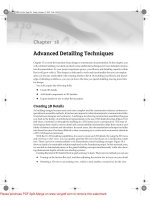Developments in Heat Transfer Part 18 pptx
Bạn đang xem bản rút gọn của tài liệu. Xem và tải ngay bản đầy đủ của tài liệu tại đây (640.18 KB, 20 trang )
source may be a black-body emitter, incandescent lamp, light emitting diode or laser, to
name a few. The rod absorbs the radiation converting it to heat. In order to approximate
cases of: 1) rod with evenly spaced side heating and varying axial heating rate or boundary
condition, and 2) end heating with arbitrarily distributed source or boundary conditions, it
is sufficient to assume an axisymmetrical case with a finite rod. Then the governing equation
becomes:
() () ()
2
2
,,,0
K
rrzK rzQrz
rr r
z
∂∂ ∂
θθ
∂
∂
∂
+
+=
(13)
(a) (b) (c)
Fig. 1. Three cylindrical optical devices: a) rod held by heatsink mounts on both ends with
radially symmetrical side induction heaters, b) rod held by a heatsink along its length with
end induction heater and c) end induction heated thin disk (dark) with a cap
2.1.1 Side heating
The boundary conditions for a rod may model various cooling configurations including
conductive and convective cooling means. A possible configuration is conduction cooling,
where a heat sink with a mount holds the rod over part of its length. This configuration
justifies the assumption of either Dirichlet or Neumann boundary conditions or their
combination specified around the rod circumference:
()
() ( )
(
)
(
)
()
12
,,
,
WW
W
rr rr
Trz rz
Tr z f z or kT K f z
rr
∂∂θ
∂∂
==
===
(14)
The Dirichlet boundary condition is particularly suitable for cases where the boundary is
held at a set temperature such as the case of heat sinking to Peltier junction or cryogenic
cooling. In terms of the function
θ
it becomes:
()
(
)
1
0
,ln
W
f
z
rz
T
θ
=
(15)
Then, the Neumann condition is suitable for cases where the boundary provides a certain
heat flux across it, as specified in Eq. 14. At the rod ends the facets are assumed insulated,
specified by Neumann condition, such that:
Heat
Inductio
n
Thin Disk
0/2
0
zzL
zz
∂θ ∂θ
∂∂
==
=
=
(16)
where the origin is at the rod center and z = L/2 is half the rod length. Modeling of the heat
source assumes a region confined both radially and axially inside the rod:
()
0
2
; 0
2
/2
(,)
0 ;
2
P
Pl
fr z
rl
Qrz
l
z
π
⎧
≤≤
⎪
⎪
=
⎨
⎪
<
⎪
⎩
(17)
where l is the length of the source region in the rod such that l≤L.
To solve the set of equations 13 – 16 it is convenient to employ the Green’s function G(r,z) in
which case for the mixed boundary conditions the general solution becomes:
() ()
()
()( )
/2 /2
3
000
1
,,,,,,,,
W
r
LL
WW
rz r f Vrzr d Q Grz dd
K
θ
ζ ζ ζ ξζ ξζξξζ
=+
∫∫∫
(18)
where the function f
3
(
ζ
) assumes either f
1
(
ζ
) or f
2
(
ζ
) defined in Eq. 14 and the function
V(r,z,r
W
,
ζ
) is either ∂G(r,z,
ξ
,
ζ
)/∂
ξ
at
ξ
=r
W
or G(r,z,r
W
,
ζ
), depending on the type of boundary
condition around the rod circumference (Dirichlet or Neumann). Green’s function is
constructed by solving the homogeneous Eq. 13, or the Laplace equation, satisfying the
specified boundary conditions of Eqs.14 and 16, and by the function holding throughout the
domain.(
Polianin, 2002) Thus G takes the form as demonstrated in (Polianin, 2002):
()
()()
()
0, 0,
2
2
11
22
,,
cos 2 cos 2
2
,,,
2
sm sm
s
mn
W
sm s smW
z
JrJ n n
LL
Grz
rL
n
Jr
L
ζ
μμξ π π
ξζ
π
μμ
∞∞
==
⎛⎞⎛⎞
⎜⎟⎜⎟
⎝⎠⎝⎠
=
⎡⎤
⎛⎞
+
⎢⎥
⎜⎟
⎝⎠
⎢⎥
⎣⎦
∑∑
(19)
where the subscript s assumes the value of either 0 or 1 corresponding to a Neumann or
Dirichlet type boundary condition, respectively. The coefficients
μ
m
are the roots of the
equation:
()
()
0
0
0; 0
0; 1
W
m
r
mW
d
Jr s
dr
Jr s
μ
μ
=
=
=
=
(20)
To present a complete solution one still needs to define the functions f
0
(r) used in Eq. 17. Let
two cases be considered:
1.
Uniform heat source distribution where:
()
0
1 ; 0
0 ;
P
P
rr
fr
rr
≤≤
⎧
=
⎨
<
⎩
2.
Gaussian heat source profile:
()
2
0
exp 2
P
r
fr
r
⎡
⎤
⎛⎞
⎢
⎥
=−
⎜⎟
⎢
⎥
⎝⎠
⎣
⎦
Considering a Dirichlet boundary condition for case 1 one may solve the problem for
θ
−
θ
W
,
whereby the first term in Eq. 18 becomes
θ
W
and the solution is expressed as:
() ()
()
()
()
/2
1
2
00
11, 01,
2
2
11
22
1, 1, 1 1,
2
,,,,
cos 2
sin
2
p
r
l
W
P
mp m
W
mn
WP
mm mW
P
rz G rz d d
rlK
z
JrJr n
Pl
L
cn
L
rrLK
n
Jr
L
θθ ξζζξξ
π
μμ π
θπ
π
π
μμ μ
∞∞
==
=+
⎛⎞
⎜⎟
⎛⎞
⎝⎠
=+
⎜⎟
⎡⎤
⎝⎠
⎛⎞
+
⎢⎥
⎜⎟
⎝⎠
⎢⎥
⎣
⎦
∫∫
∑∑
(21)
Considering a Neumann boundary condition for case (1), and assuming a case where the
heat is relieved from the rod by conductive mounts holding the rod perimeter between ±S/2
and ±L/2 Eq. 18, the solution is:
()
()
()
()
()
()
()
/2 /2
00
2
/2 0 0
1, 0 1,
2
11
2
1, 1 1,
10, 00,
2
2
,,,, ,,,
sin cos 2
2
cos
sin
p
r
Ll
B
abs
WW
P
S
mm
B
W
mn
mmW
mp m
WP
q
P
rz r G rzr d G rz d d
K
rlK
Jr
q
SS z
cn n
Kr L L L
n
Jr
L
JrJr
Pl
cn
L
rrLK
η
θζζξζζξξ
π
μμ
ππ
π
μμ
μμ
π
π
∞∞
==
=+
⎛⎞ ⎛ ⎞
=
⎜⎟ ⎜ ⎟
⎡⎤
⎝⎠ ⎝ ⎠
⎛⎞
+
⎢⎥
⎜⎟
⎝⎠
⎢⎥
⎣⎦
⎛⎞
+
⎜⎟
⎝⎠
∫∫∫
∑∑
()
2
11
22
0, 0, 0 0,
2
2
mn
mm mW
z
n
L
n
Jr
L
π
π
μμ μ
∞∞
==
⎛⎞
⎜⎟
⎝⎠
⎡⎤
⎛⎞
+
⎢⎥
⎜⎟
⎝⎠
⎢⎥
⎣
⎦
∑∑
(22)
where q
B
is the heat flux through the cooling mounts. For a very long rod the solutions in
Eqs. 21 and 22 approach the asymptotic solution for a two dimensional, axisymmetrical
geometry, which for the Dirichlet boundary condition becomes:
()
2
2
2
2
exp 1 ; 0
4
2
;
eff
eff
P
LK
W
P
Peff
P
P
eff W
LK
W
PW
r
Pr
rr
rLK
r
P
Tr T
Lhr
r
rrr
r
π
π
π
π
∞
⎧
⎡⎤
⎛⎞
⎛⎞
⎪
−
≤≤
⎢⎥
⎜⎟
⎜⎟
⎪
⎜⎟
⎛⎞
⎢⎥
⎪
⎝⎠
⎝⎠
⎣⎦
⎜⎟
=+
⎨
⎜⎟
⎪
⎝⎠
⎛⎞
⎪
<≤
⎜⎟
⎪
⎝⎠
⎩
(23)
For the heat source of case 2 with Gaussian radial distribution the integrand becomes a
product of Bessel function of the first kind of order zero and Gauss function. Then, the
integral in the second term of Eq. 18 becomes:
()
0
0
exp 2
W
r
m
P
Jd
r
ξ
μ
ξξξ
⎡⎤
⎛⎞
−
⎢⎥
⎜⎟
⎢⎥
⎝⎠
⎣⎦
∫
(24)
which has a closed form solution strictly for the case of r
W
→∞, being ( Abramowitz &
Stegun, 1964):
()
2
2
exp
48
mP
P
r
r
μ
⎡
⎤
⎢
⎥
−
⎢
⎥
⎣
⎦
(25)
It turns out that for r
W/
r
P
=1, 1.25, 1.5, 1.75 the above result has an error of 15%, 6%, 1.5%
and less than 1% relative to a numerical approximation, respectively. Because in real
scenarios r
W/
r
P
>1, this result is applicable to the present solution assuming a Dirichlet
boundary condition, yielding:
()
()
()
()
2
01,
1,
2
2
11
22
1, 1 1,
cos 2
,expsin
8
4
2
m
mP
W
mn
W
mmW
z
Jr n
r
Pl
L
rz c n
L
rLK
n
Jr
L
μπ
μ
θθ π
π
π
μμ
∞∞
==
⎛⎞
⎡⎤
⎜⎟
⎛⎞
⎝⎠
⎢⎥
=+ −
⎜⎟
⎢⎥
⎡⎤
⎝⎠
⎛⎞
⎣⎦
+
⎢⎥
⎜⎟
⎝⎠
⎢⎥
⎣⎦
∑∑
(26)
The temperature in the cylinder for each case is derived via Eq. 6 using the values of
θ
in
Eqs.21, 22 and 26.
2.1.2 End heating
This case is illustrated in Figure 1(b). Treating the problem of end heating is not much
different than the above model for side heating. The main difference is in defining the heat
source as an exponentially decaying function along the rod axis. Thus in end heating the
temperature becomes maximized at the rod facet. The temperature surge is milder if an end-
cap made up of a non-heating material, is bonded to the rod at the entrance. A non-heating
material may be one which does not contain a heat source. The non-heating end-cap
conducts the heat generated in the rod. Assumed in the present model is an identical
coefficient of thermal conductivity in the heating and non- heating materials. For the sake of
smooth transition from the previous section a notation is selected such where L/2 expresses
the entire rod length. In sum the heat source in the rod becomes:
()
0
2
0 ;
2
( , ) exp ; 0 0
22
0 ;
C
CCP
P
P
L
zz
PL L
Qrz z z
f
rzzrr
r
rr
αα
π
⎧
−<
⎪
⎪
⎡⎤
⎪
⎛⎞
=
−−− ≤≤−∩≤≤
⎨
⎜⎟
⎢⎥
⎝⎠
⎣⎦
⎪
⎪
<
⎪
⎩
(27)
where z
C
is the thickness of the end cap, becoming zero for the case with no cap. As in the
previous section also here considered are two cases of radial heat induction distribution: a
flat-top beam and Gaussian. Also cooling of the rod is modeled by assuming either setting
the radial rod wall at a constant temperature or by a conductive mount holding the rod
between the lengths of S/2 and L/2 on each side.
The solution for a rod with uniform heat source and Dirichlet conditions on the cylinder
circumference becomes:
()
()
()()
()()
()
2
2
11, 01,
2
2
11
22
1, 1 1,
2
1,
2
,
2
1cos2 sin2 exp
2
cos 2
2
2
W
PW
n
CC
C
mP m
mn
mmW
m
LP
rz
rr K
zz
nL
nn z
JrJr
LL L
z
n
L
Jr
n
nL
L
α
θθ
π
π
ππα
μμ
α
π
μμ
π
πα μ
∞∞
==
=+
⎧⎫
⎡⎤⎡⎤
⎛⎞ ⎛⎞
⎛⎞
−+ −−−
⎨⎬
⎜⎟⎜⎟ ⎜⎟
⎢⎥⎢⎥
⎝⎠
⎝⎠ ⎝⎠
⎛⎞
⎣⎦
⎣⎦
⎩⎭
×
⎜⎟
⎡⎤
⎝⎠
⎛⎞
⎡⎤
++
⎢⎥
⎜⎟
⎣⎦
⎝⎠
⎢⎥
⎣
⎦
∑∑
(28)
Considering the Neumann boundary condition the solution is expressed as:
()
()
()
()
()
()
()
/2 /2
00
2
/2 0 0
1, 0 1,
2
11
2
1, 1 1,
10, 00,
2
0, 0,
2
,,,, ,,,
sin cos 2
2
sin
p
r
Ll
B
WW
P
S
mm
B
W
mn
mmW
mp m
WP
m
q
P
rz r G rzr d G rz d d
K
rlK
Jr
q
SS z
cn n
Kr L L L
n
Jr
L
JrJr
Pl
cn
L
rrLK
θζζξζζξξ
π
μμ
ππ
π
μμ
μμ
π
π
μμ
∞∞
==
=+
⎛⎞ ⎛ ⎞
=
⎜⎟ ⎜ ⎟
⎡⎤
⎝⎠ ⎝ ⎠
⎛⎞
+
⎢⎥
⎜⎟
⎝⎠
⎢⎥
⎣⎦
⎛⎞
+
⎜⎟
⎝⎠
∫∫∫
∑∑
()
2
11
22
00,
cos 2
2
mn
mmW
z
n
L
n
Jr
L
π
π
μ
∞∞
==
⎛⎞
⎜⎟
⎡⎤
⎝⎠
⎛⎞
+
⎢⎥
⎜⎟
⎝⎠
⎢⎥
⎣
⎦
∑∑
(29)
Finally, the solution for a rod with a Gaussian heat source and Dirichlet conditions on the
cylinder circumference becomes:
()
()
()
()()
()
()
2
2
2
1
01,
2
2
11
22 11,
2
1,
,
2
2
exp 1 cos 2 sin 2 exp
82
cos 2
2
2
W
W
mp
n
CC
C
m
mn
mW
m
LP
rz
rK
r
zz
nL
nn z
LL L
Jr
z
n
L
Jr
n
nL
L
α
θθ
π
μ
π
ππα
α
μ
π
μ
π
πα μ
∞∞
==
=+
⎡⎤
⎧⎫
⎡⎤
⎡⎤
⎛⎞ ⎛⎞
⎛⎞
⎢⎥
−− + −−−
⎨⎬
⎜⎟
⎜⎟ ⎜⎟
⎢⎥
⎢⎥
⎢⎥
⎝⎠
⎝⎠ ⎝⎠
⎣⎦⎣⎦
⎩⎭
⎢⎥
⎛⎞
⎣⎦
×
⎜⎟
⎡⎤
⎝⎠
⎛⎞
⎡⎤
++
⎢⎥
⎜⎟
⎣⎦
⎝⎠
⎢⎥
⎣
⎦
∑∑
(30)
2.2 Example for a cylindrical rod
Several cases are calculated showing the profiles of temperature in nonlinear materials. To
allow a reasonable comparison between the various cases the following parameters are set:
material Yb:YAG, rod diameter 5 mm, radiation absorbing zone diameter 2.5 mm and
cryogenic cooling at 77K. Assumed is a circumferential, radially directed radiation forming
a uniform heat zone.
To estimate the effect of the rod aspect ratio on the axial temperature distribution let a heat
density of 410 W/cm
3
be set while varying the rod length. Plotted in Figure 2(a) is the axial
temperature for half a rod from center to facet with a varying length. Observe that for short
rods the temperature is relatively small, growing with length to an asymptotic value.
Further length increase causes the temperature profile to flatten out reaching an asymptotic
value set by an infinitely long rod. A length of 50 mm may be considered as the value at
which the rod is well approximated by an infinitely long rod. Then, the temperature profile
is calculated assuming power magnitudes of P=240, 400 and 800 W and a rod length of 50
mm, corresponding to heat density rates of 245, 410 and 815 W/cm
3
, respectively. Shown in
Figure 2(b) is the radial distribution through a rod center for using finite and infinite rod
models yielding essentially identical results. Also in Figure 2(b) a comparison is made with
a calculation based on the linear solution where k is assumed constant equal to that for the
median temperature in the rod. In
Figure 2(c) plotted are the temperature radial profiles for
all three heat density levels, compared again to the linear approach, exhibiting a gradually
growing discrepancy between the two for large power levels. It follows that the linear
approach is unjustifiable for large heat loads, say above 200 W/cm
3
.
(a)
(b) (c)
Fig. 2. Temperature in a rod: a) axial distribution for heat density of 410 W/cm
3
, b) radial
distribution for heat density of 410 W/cm
3
, comparing rod with finite and infinite length
and with the linear solution, and c) radial distribution for heat density of 245, 410 and 815
W/cm
3
, comparing the nonlinear with linear solutions
2.3 Heated thin disk
Illustrated in Figure 1(c), the heated disk experiences greatly diminished radial temperature
gradients due to its large area at an axial end being cooled. The thermal problem is solved as
in the section above with the difference that here one of the axial facets is attached to a heat
sink thus setting the temperature. The other facet is assumed either insulated or bonded to a
non-heating layer, a cap. Specifying the boundary conditions for the disk radial wall is
twofold: it is insulated for a non-heating disk whereas for a capped disk it has a set
temperature, same as the heat-sunk end. Note that for the case of the uncapped end there is
no substantial advantage to adding thermal contact to the radial wall due to the large aspect
ratio of the disk. On the other hand, for the capped-end case radial cooling must be assumed
to render the cap useful.
Further assumed is a heat source with flat-top profile enveloped by a circular cylinder with
a radius of r
P
. Denoting the disk thickness as t the heat source density is expressed as:
()
2
0 ;
;0
0;
C
p
P
p
tz z
P
Qr r r
rt
rr
π
⎧
−<
⎪
⎪
=≤≤
⎨
⎪
⎪
<
⎩
(31)
Then, the boundary conditions are:
(
)
(
)
()
W
,,
0 ; 0 for uncapped disk
, for capped disk
W
zt rr
W
rz rz
zr
rz
∂θ ∂θ
∂∂
θθ
==
==
=
(32)
and the end cooled boundary condition becomes:
(
)
,0
W
r
θ
θ
= (33)
Green’s function for the Neumann and Dirichlet cases denoted by the subscript s (=0, 1)
becomes:
()
()()
()
00
2
2
10
22
11
sin sin
22
2
,,,
1
2
sm sm
s
mn
W
sm s sm W
z
JrJ n n
tt
Grz
rt
nJr
t
ζ
μμξ π π
ξζ
π
μμ
∞∞
==
⎡
⎤⎡ ⎤
⎛⎞ ⎛⎞
++
⎜⎟ ⎜⎟
⎢
⎥⎢ ⎥
⎝⎠ ⎝⎠
⎣
⎦⎣ ⎦
=
⎧⎫
⎡⎤
⎪⎪
⎛⎞
++
⎨⎬
⎜⎟
⎢⎥
⎝⎠
⎣⎦
⎪⎪
⎩⎭
∑∑
(34)
Thereby the solution takes the form:
() ()( )
()
()
()
()
00
1, 0,
22
2
11
22
,, 0,
1
,,,,,
11
1sin 1 sin
22
4
21
1
2
W
r
t
sW s
n
C
sm p sm
W
mn
Wp
sm sm smW
rz Q G rz d d
K
z
z
nJrJrn
tt
P
n
rrtK
nJr
t
θθ ξζ ξζζξξ
πμμ π
θ
π
π
μμ μ
∞∞
==
=+
⎡
⎤⎡⎤
⎛⎞ ⎛⎞
−+− +
⎜⎟ ⎜⎟
⎢
⎥⎢⎥
⎝⎠ ⎝⎠
⎣
⎦⎣⎦
=+
+⎧ ⎫
⎡⎤
⎪⎪
⎛⎞
++
⎨⎬
⎜⎟
⎢⎥
⎝⎠
⎣⎦
⎪⎪
⎩⎭
∫∫
∑∑
(35)
with the physical stipulation that for s=0 z
C
=0. Thence the temperature is derived as:
()
()
()
()
()
1, 0,
22
2
11
22
,, 0,
11
1 sin 1 sin
22
4
,exp
21
1
2
n
C
sm p sm
sW
mn
Wp
sm sm sm W
z
z
nJrJrn
tt
P
Trz T
n
rrtK
nJr
t
πμμ π
π
π
μμ μ
∞∞
==
⎧
⎫
⎡
⎤⎡⎤
⎛⎞ ⎛⎞
⎪
⎪
−+− +
⎜⎟ ⎜⎟
⎢
⎥⎢⎥
⎪
⎪
⎪
⎪
⎝⎠ ⎝⎠
⎣
⎦⎣⎦
=
⎨
⎬
+
⎧⎫
⎪
⎪
⎡⎤
⎪⎪
⎛⎞
++
⎨⎬
⎜⎟
⎪
⎪
⎢⎥
⎝⎠
⎣⎦
⎪⎪
⎪
⎪
⎩⎭
⎩ ⎭
∑∑
(36)
Evidently the temperature grows exponentially with the dissipated heat density.
(a) (b)
(c) (d)
(e) (f)
(g) (h)
Fig. 3. Radial and axial temperature profiles in a thin disk assuming a cap length of 0 (a,b),
0.25 mm (c,d), 0.75 mm (e,f) and 1.25 mm (g,h)
2.4 Example for a thin disk
To calculate the temperature in the disk the following parameters are set: material Yb:YAG,
disk diameter 5 mm, heat source diameter or thickness 2.5 mm, slab lengths 50 mm, disk
thickness 0.25 mm, heat density rate 100 W/cm
3
and cryogenic cooling at 77K.
Consistent with most realistic scenarios consider end heating of the thin disk with uniform
radial distribution within a radius of r
P
of a disk attached to a heat sink. To enhance heat
dissipation assumed is also a non-heating cap in good thermal contact with the disk and a
heat sink around its perimeter. For simplicity the cap is considered possessing the identical
values of coefficient of thermal conduction of the absorbing disk. Thus attached to the disk
with the thickness of 0.25 mm is a cap with a varying thickness of 0, 0.25, 0.75 and 1.75 mm.
For a heat sink temperature of 77K, disk diameter of 5 mm, source diameter of 2.5 mm and
power P=400 W the temperature axial and radial profiles are plotted in
Figure 3. On
inspecting the graphs (a) – (h) one finds a dramatic drop in the maximum temperature of
above 300K to below 90K resulting from increasing the cap thickness from nil to 1.75 mm.
Another interesting point is that the axial location of the hottest spot remains at roughly the
doped disk facet. Next, the axial and radial profiles of
Δ
n radial component are plotted in
Figure 3. On inspecting the graphs (a) – (h) one finds a dramatic decrease in the
Δ
n
magnitude from 2.5×10
-3
to below 4×10
-5
with increasing the cap thickness. Also the axial
location of the peak
Δ
n remains at the doped disk facet.
3. Slab geometry
For active optical media having the shape of a parallelepiped it is most convenient to treat
Eq. 5 in Cartesian coordinates, where consistent with Kirchoff’s transformation (
Joyce, 1975)
it is expresses as:
()()
222
222
,, ,, 0K xyz Qxyz
xyz
θ
⎛⎞
∂∂∂
+
++=
⎜⎟
⎜⎟
∂∂∂
⎝⎠
(37)
3.1 Slab of infinite length
The case of a very long slab relative to its lateral sides is well approximated by an infinitely
long slab is schematically shown in
Figure 4(a). Here the slab is held on one side in thermal
contact with the heat sink, having its width in the z direction and thickness in x direction,
both much shorter than its length in the y direction. Heating sources such as lasers, emit
radiation which forms inside the slab a laser gain zone a fraction of which generates heat
due to the quantum defect and other non-radiative relaxation processes.
Considered is a side-heated model having a slander spot shape on the slab side. It has
predominantly a Gaussian intensity distribution in the fast-axis plane, i.e. along x, and a
uniform distribution along y.
I choose to specify the boundary conditions as:
0
0
(,) (,) (,)
0
x
yyb
Txy Txy Txy
yyx
=
==
∂∂∂
=
==
∂∂∂
(38)
and:
(,)
W
Tay T= (39)
where T
W
is the temperature of the heat-sink at the interface with the slab wall. In the notation
of the non-dimensional temperature
θ
the two-dimensional Poisson equation becomes:
()
(
)
22
22
,
,0
Qxy
xy
K
xy
θ
⎛⎞
∂∂
+
+=
⎜⎟
⎜⎟
∂∂
⎝⎠
(40)
with the boundary conditions thus converted to:
0
0
(,) (,) (,)
0; (,)
W
x
yyb
xy xy xy
ay
yyx
θθθ
θ
θ
=
==
∂∂∂
=== =
∂∂∂
(41)
For a constant
θ
W
this allows a solution for the function (,)
W
xy
θ
θ
− with a zero boundary
value at x=a.
Assumed for this case is a heat source:
()
()
0
(,) exp
2
P
P
Qxy y f x
rL
α
α
=−
(42)
where
α
is the absorption coefficient of the laser radiation, r
P
is the small aperture of the
radiation beam, a, b and L are the x , y and z dimensions of the slab (a,b<<L). If the slab side
at y=b reflects the inducing beam then the heat source becomes:
(
)
()
()
0
exp
(,) cosh
P
Pb
Qx
y
b
yf
x
rL
α
α
α
−
⎡⎤
=−
⎣⎦
(43)
The formal solution to the equation set 40 – 41 is:
()
()
()
00
1
, , ,,,
ab
W
xy Q Gxy dd
K
θ
θξηξηξη
=+
∫∫
(44)
where the Green’s function construction is stipulated by solving the homogeneous Eq. 40, or
the Laplace equation, by satisfying the boundary conditions and by its holding throughout
the domain. It results in:
()
(
)
(
)
(
)
(
)
22
10
cos cos sin sin
4
,,,
llmm
lm
lm
py p q x q
Gxy
ab
pq
η
ξ
ξη
∞
∞
==
=
+
∑∑
(45)
where:
1
;
2
lm
l
pqm
ba
π
π
⎛⎞
==+
⎜⎟
⎝⎠
(46)
To present a complete solution one still needs to define the functions f
0
(x) used in Eq. 42. Let
two cases be considered:
1.
uniform heat source distribution in the x axis where:
()
0
1 ;
22
0 ;
22
PP
PP
aa
rx r
fx
aa
xr rx
⎧
−≤≤+
⎪
⎪
=
⎨
⎪
<−∩ + <
⎪
⎩
2. Gaussian heat source profile:
()
2
0
/2
exp 2
P
xa
fx
r
⎡
⎤
⎛⎞
−
⎢
⎥
=−
⎜⎟
⎢
⎥
⎝⎠
⎣
⎦
Considering case (1), Eq. 44 is integrated to the closed form solution:
()
()
()
()()
()( )
2
2222
00
11 sin sin
2
,4 cossin
l
b
m
mP
W lm
P
lm
ml l m
qa
eqr
P
xy py q x
rabLK
qp p q
α
α
θθ
α
−
∞∞
==
⎛⎞
⎡⎤
−−
⎜⎟
⎣⎦
⎝⎠
=+
++
∑∑
(47)
when no electromagnetic radiation is reflected from slab end, and to:
()
()
()
()()
()( )
2
2222
00
sinh( )sin sin
exp
2
,8 cossin
m
lmP
W lm
P
lm
ml l m
qa
pb q r
Pb
xy py q x
rabLK
qp p q
αα
θθ
α
∞∞
==
⎛⎞
⎜⎟
−
⎝⎠
=+
++
∑∑
(48)
when the electromagnetic radiation is fully reflected from slab end.
Then for case (2) the solution takes the form:
()
()
()()
()
()( )
()
()()
()
2
2
2
8
2222
10
22
2
8
2222
0
11
,42 sin
2
22
erf erf cos sin
22 22
11
82 sin
2
mP
mP
qr
l
b
m
W
lm
mlm
mP mP
lm
PP
qr
l
b
m
W
m
mlm
e
qa
P
xy e
abLK
ppq
iq r a iq r a
py q x
rr
e
qa
P
e
abLK
ppq
α
α
α
θθ π
α
α
θπ
α
−
∞∞
−
==
−
∞
−
=
−−
⎛⎞
=−
⎜⎟
⎝⎠
++
⎡⎤
⎛⎞⎛⎞
−−
×−
⎢⎥
⎜⎟⎜⎟
⎜⎟⎜⎟
⎢⎥
⎝⎠⎝⎠
⎣⎦
−−
⎛
≈−
⎜
⎝
++
∑∑
∑
()( )
()
()
()
()
22
2
1
1
4
2
1
2
cos sin
2
erf 1 cos 2 1 cosh cos
2
2
4
sinh sin
2
PP
lm
l
aa
n
rr
mP
m m
P P
n
P
P
mP
m
py q x
nq r
ae e e a
q
a
q
a
a
rr
a
n
r
r
nq r
nqa
π
π
∞
=
⎛⎞ ⎛⎞
−−
⎜⎟ ⎜⎟
−
∞
⎝⎠ ⎝⎠
=
⎞
⎟
⎠
⎧
⎪
⎡
⎛⎞
⎛⎞
⎪
⎛⎞
×+ − + −
⎨
⎜⎟
⎢
⎜⎟
⎜⎟
⎝⎠
⎝⎠
⎝⎠ ⎛⎞
⎣
⎪
+
⎜⎟
⎪
⎝⎠
⎩
⎫
⎤
⎛⎞ ⎪
+
⎬
⎥
⎜⎟
⎝⎠
⎪
⎦
⎭
∑
∑
(49)
where p
m
is defined in Eq. 46. On inspecting Eqs. 47 and 49 one observes that for a>>r
P
the
solution is insensitive to the magnitude of r
P
.
3.2 Slab of finite length
The heat conduction problem in a slab of finite length is three dimensional, covering the
cases illustrated by
Figure 4(a) and (b), where a slab is held on one side in thermal contact
with a heat sink and is either side heated (a), or end heated (b). The coordinate system is
chosen to represent length in z axis and comparable width sizes in x and y axis. The
governing equation is the Poisson equation in Cartesian coordinates, with respect to all
three axes as given in Eq. 37. Several configurations of heat inductions are considered:
1) side heat induction in the y direction where the source has an oblong spot shape and a
Gaussian intensity distribution in x, 2) side heat induction with alternating directions of + y
and –y, and 3) end heat source in the z direction having a circular spot shape and Gaussian
intensity distribution. Also solved is a case for a heat source additional to that occurring in
the heating path, which originates from fluorescence and photon trapping in the slab bulk
and walls. Finally, several cases of slab cooling are considered: 1) contact with heat sink on
one of the slab sides, 2) contact with heat sink on two of the slab sides, and 3) contact with
heat sink on all four of the slab sides.
(a) (b)
Fig. 4. Two parallelepipeds: a) slab attached to a heatsink on one side, with a slender side
pump and, b) slab attached to heatsink on one side with an end pump
3.2.1 Side heating
In this case the crystal is considered three dimensional, in thermal contact with a heat sink
on one side, thus there are five Neumann and a single Dirichlet type boundary conditions.
They are expressed as:
0 0
0
(,,) (,,) (,,) (,,) (,,)
0
zzL x
yyb
xyz xyz xyz xyz xyz
zzyyx
θθθθθ
== =
==
∂∂∂∂∂
=
====
∂∂∂∂∂
(50)
and:
'(,,) (,,) 0
W
ayz ayz
θ
θθ
=−=
Consequently the Green’s function becomes:
()
(
)
(
)
(
)
(
)
()
()
01
cos cos cos cos
1
,,,,, ,
cosh
nnmm
nm
nm nm
nm
px p q y q
Gxyz Hz
ab L
ξη
ξ
η
ζζ
ββ
∞∞
==
=
∑∑
(51)
where the function H
nm
(z,
ζ
) is:
()
()
()
()
()
cosh cosh ; 0
,
cosh cosh ; 0
nm nm
nm
nm nm
Lz Lz
Hz
zLLz
βζ β ζ
ζ
ββζ ζ
⎧
⎡
−⎤ ≥>≥
⎪
⎣⎦
=
⎨
⎡
−⎤ ≥>≥
⎪
⎣⎦
⎩
(52)
and the coefficients p
n
, q
m
and
β
nm
are:
22
1
2
;;
nmnmnm
n
m
pqpq
ab
π
π
β
⎛⎞
+
⎜⎟
⎝⎠
===+
(53)
Further, allowing for a non-absorbing cap having thickness of b
C
on the radiation side the
heat source is defined as:
()
()
0
0 ;
(,,)
exp , ;
2
C
CC
PP
yb
Qxyz
P
y
bfxz byb
rL
α
α
<
⎧
⎪
=
⎨
⎡⎤
−
−≤≤
⎣⎦
⎪
⎩
(54)
where L
P
is the radiation length and the term f
0
defines the lateral profile of the source,
assumed either as flat top or Gaussian:
1.
flat top:
()
0
1 ; 0 0
2
,
0 ; , or
22
PP
PP P
a
xr zL
fxz
aa
rxx r Lz
⎧
≤−≤ ∩ ≤≤
⎪
⎪
=
⎨
⎪
+
<<− <
⎪
⎩
(55)
2.
Gaussian:
()
2
0
/2
1 ; exp 2 0
,
0 ;
P
P
P
xa
zL
fxz
r
Lz
⎧
⎡⎤
⎛⎞
−
⎪
⎢⎥
−∩≤≤
⎪
⎜⎟
=
⎢⎥
⎨
⎝⎠
⎣⎦
⎪
<
⎪
⎩
(56)
The formal solution takes the shape:
()
()
()
0
000
,, ,, ,,,,,
abL
x
y
zQGx
y
z ddd
θ
θξη
ζ
ξη
ζ
ξη
ζ
=+
∫∫∫
(57)
which after substituting the functions given in Eqs. 51 and 54 and carrying out the
integration becomes:
()
()
{}
()
()
()
()()
()
2
0
2
222
01
,,
1exp
11sin cos
2
cos cos
cosh
tanh sinh
cosh
c
z
PC
m
nP n
nm
nm
nmnm
nm
nm nm P
nm
Pe
xyz
rabK b b
a
pr p
p
xqy
pq
z
LLL
L
α
α
θθ
πα
αβ
β
ββ
β
∞∞
==
=+
⎡⎤
−−−
⎣⎦
⎛⎞
⎡⎤
−−
⎜⎟
⎣⎦
⎝⎠
×
+
⎡⎤
×−−
⎢⎥
⎣⎦
∑∑
(58)
Observe that for r
P
=a/2 the term
(
)
(
)
sin cos /2
nP n
pr pa becomes
()
1/2
n
− , and for L=L
P
the
term in the square parenthesis becomes merely
tanh
nm
L
β
thus rendering the solution in Eq.
58 independent of z.
Often radiation sources are placed successively on both sides of a slab. In order to solve for
this case one needs only to add a second source placed on the other side of the slab, whereby
the governing equation and boundary conditions remain as stated above, however the heat
source is defined as:
()
()
()
0
0 ;
exp
(,,)
, ;
2
1exp 2
CC
C
CC
PP
C
bb yb
bb y
Qxyz
P
f
xz b y b b
rL
bb
αα
α
−<<
⎧
⎪
⎡⎤
−−−
=
⎨
⎣⎦
≤≤−
⎪
⎡⎤
−−−
⎣⎦
⎩
(59)
where the term f
0
is assumed either flat top:
()
0
1 ; 0 2
2
,
0 ; , or ; 2
22
PPP
PP PP
a
xr LzL
fxz
aa
rxx r zL Lz
⎧
≤−≤ ∩ ≤≤
⎪
⎪
=
⎨
⎪
+
<<− < <
⎪
⎩
(60)
The solution to this problem becomes:
()
()
{}
()
() ()()
()
2
0
222
01
,,
21exp
cos cos sin sin
sin cos cos cos
2
co
cosh
tanh sinh 2 sinh
cosh
cc
B
PP C
bb
BB
m
mmc mmc
nm
nmnm
nP n n m
nm
nm nm P nm P
nm
Pe
xyz
rLabK b b
q
e qBe qb e qBe qb
pq
a
pr p px q y
z
LLL L
L
α
αα
αα
α
θθ
α
α
αβ
β
ββ β
β
−
∞∞
==
=+
⎡⎤
−−−
⎣⎦
⎡⎤⎡⎤
−+ −
⎣⎦⎣⎦
×
+
⎛⎞
×
⎜⎟
⎝⎠
×−− −
∑∑
()
sh
cosh
nm
nm
Lz
L
β
β
⎡
⎤
−
⎢
⎥
⎣
⎦
(61)
The complete solution to the slab induced by two sources disposed successively on opposite
sides of the slab is the combination of Eqs.58 and 61. Note that by this technique one can to
arbitrarily add additional induction sources on the slab sides arriving at a closed form
solution for each configuration. Finally, using this solution the temperature is again derived
via Eq. 6.
3.2.2 End heating
Treating the problem of end heat induction is in fact exactly that as the above model for
side heat induction however with changing the characteristics of the source. The heat
source is now considered axisymmetrical with a Gaussian power distribution. In end
heating the temperature is maximized at the slab facet. This surge may be relieved by
bonding to the entrance facet of the slab a non-heating end-cap segment. Lacking a heat
source yet being heat conductive contributes to removing heat from the slab facet. In the
present model it is assumed that the coefficient of thermal conductivity in both materials
is identical. For this case with the radiator aligned to the slab centerline the heat source
term is rewritten as:
()
()
()
0
2
0 ;
exp
(,,)
, ;
1exp
C
C
C
C
P
zz
zz
Qxyz
P
fxy z zL
Lz
r
αα
α
π
<
⎧
⎪
⎡⎤
−−
=
⎨
⎣⎦
≤≤
⎪
⎡⎤
−−−
⎣⎦
⎩
(62)
where f
0
is given by:
()
22
0
/2
/2
,exp2
PP
yb
xa
fxy
rr
⎧
⎫
⎡
⎤
⎛⎞⎛⎞
−
−
⎪
⎪
⎢
⎥
=− +
⎨
⎬⎜⎟⎜⎟
⎢
⎥
⎝⎠⎝⎠
⎪
⎪
⎣
⎦
⎩⎭
(63)
Again, the heat source in the slab can be expressed by Eq. 57, which after substituting the
functions given in Eqs.51 and 54 and carrying out the integration becomes:
()
()
{}
()()
()()
()
2
0
01
22
1
,,
4
1exp
cos cos
,,
cosh
1
cosh cosh sinh
c
z
C
nm
nn mm
nm nm
nm
Lz
nm
nm nm nm
nm
Pe
xyz
abK b b
px q y
FpaFq b
L
Lz e z e L
α
αα
α
θθ
α
ββ
β
βββ
α
αβ
∞∞
==
−−
=+
⎡⎤
−−−
⎣⎦
×
⎡
⎤
×−−−
⎢
⎥
−
⎣
⎦
∑∑
(64)
where:
()
()
()
2
2
2
0
0
2
4
2
0
2
22
erf
2
,exp cos
82
1 cos cosh
22
2
P
a
r
nP
n
k
nn
nP
n
k
P
aa
e
r
r
pr
pa
Fpa
kp r
e
pa
a
k
r
π
⎛⎞
−
⎜⎟
⎝⎠
−
∞
=
⎧
⎫
⎛⎞
⎪
⎪
+
⎜⎟
⎪
⎪
⎜⎟
⎝⎠
⎪
⎪
⎡⎤
⎛⎞
⎪
⎪
⎢⎥
=−
⎨
⎬
⎜⎟
⎢⎥
⎝⎠
⎡
⎤
⎛⎞
⎪
⎪
⎣⎦
×−
⎢
⎥
⎜⎟
⎪
⎪
⎝⎠
⎣
⎦
⎛⎞
⎪
⎪
+
⎜⎟
⎪
⎪
⎝⎠
⎩⎭
∑
(65)
Note that in the above equation the index n, coefficient p
n
and length a can be replaced by m,
coefficient q
m
and length b, respectively. Next, the function F can be further simplified
considering the values of the coefficients p
n
and q
m
as given in Eq. 53 provides the following
values:
()
()
()
1111
cos , , , , for 0,1,2,3,
2
2222
cos 0
cos 0, 1,0,1, for 1,2,3,4
2
cos 1
n
n
m
m
m
pa
n
pa
qb
m
qb
⎛⎞
=−− =
⎜⎟
⎝⎠
=
⎛⎞
=− =
⎜⎟
⎝⎠
=−
(66)
It should be mentioned that the F function is a close approximation to a combination of error
functions of complex arguments as shown in (Abramowitz & Stegun, 1964).
3.2.3 Additional case – slab attached to a heat sink on two sides
Selecting next to carry out the solution for the case of a slab held in thermal contact with a
heat sink on two adjacent walls, the boundary conditions are specified as:
00
0
(,,) (,,) (,,) (,,)
0
zzLx
y
Txyz Txyz Txyz Txyz
zzxy
===
=
∂∂∂∂
=
===
∂∂∂∂
(67)
and:
(,,) (,,)
W
Tayz Txbz T
=
= (68)
Relative to the dimensionless temperature
θ
the boundary conditions become:
00
0
(,,) (,,) (,,) (,,)
0
zzL x
y
xyz xyz xyz xyz
zzyx
θθθθ
== =
=
∂∂∂∂
=
===
∂∂∂∂
(69)
and:
(,,) (,,) 0ayz xbz
θθ
==
The formal solution is given by Eq. 57 with the heat source Q given by Eq. 62. The Green’s
function is constructed according to that the rules explained in the previous section, thus
becoming as in Eqs.51 and 52 however with the set of coefficients p
n
, q
m
and
β
nm
are
22
11
:;
22
nmnmnm
p
nqm pq
ab
ππ
β
⎛⎞ ⎛ ⎞
=+ = + = +
⎜⎟ ⎜ ⎟
⎝⎠ ⎝ ⎠
(70)
Because both walls attached to the heat sink are held at the uniform temperature of T
W
, the
solution is identical to that in Eqs.64 and 65 with the difference of the coefficient q
m
and that
the summation over m begins at 0.
3.2.4 Additional case – slab attached to a heat sink on four sides
In comparison with a slab in contact with a heat sink on two sides a surrounding heat sink
on four sides is expected to further lower the temperature elevation due to heating. Unlike
in the case where the slab is held by two sides, where the boundary conditions have four
Neumann and two Dirichlet type conditions, for this case there are two Neumann and four
Dirichlet type conditions expressed as:
0
(,,) (,,)
0
zzL
xyz xyz
zz
θθ
==
∂∂
=
=
∂∂
(71)
and:
(0,,) (,,) (,0,) (,,) 0yz ayz x z xbz
θ
θθθ
====
One may approach a solution using symmetry considerations solving in the x and y
coordinates instead of the domain 0→a and 0→b, respectively, in the domain 0→a/2 and
0→b/2. Since in this case the heat source Q given by Eq. 62 is slightly modified to conform
with the symmetry consideration such that the f
0
function is expressed as:
()
22
0
,exp2
PP
y
x
fxy
rr
⎧
⎫
⎡
⎤
⎛⎞ ⎛⎞
⎪
⎪
⎢
⎥
=− +
⎨
⎬
⎜⎟ ⎜⎟
⎢
⎥
⎝⎠ ⎝⎠
⎪
⎪
⎣
⎦
⎩⎭
(72)
In this domain the solution is identical to the case of a slab held by a heat sink on two sides,
for which the solution is given by Eq. 64 where the F
n
function is expressed as:
()
()
()
2
2
2
0
2
4
2
0
2
22
erf
2
,exp
8
1cos cosh
22
2
P
a
r
P
nP
k
nn
nP
n
k
P
aa
e
r
r
pr
Fpa
kp r
e
pa
a
k
r
π
⎛⎞
−
⎜⎟
⎝⎠
−
∞
=
⎧
⎫
⎛⎞
⎪
⎪
+
⎜⎟
⎪
⎪
⎜⎟
⎝⎠
⎪
⎪
⎡⎤
⎪
⎪
⎢⎥
=−
⎨
⎬
⎢⎥
⎡
⎤
⎛⎞
⎪
⎪
⎣⎦
×−
⎢
⎥
⎜⎟
⎪
⎪
⎝⎠
⎣
⎦
⎛⎞
⎪
⎪
+
⎜⎟
⎪
⎪
⎝⎠
⎩⎭
∑
(73)
Further, the set of coefficients p
n
, q
m
and
β
nm
as expressed in Eq. 70.
3.3 Example for slab
To calculate the temperature in the slab the following parameters are set: material Yb:YAG,
square slab side 5 mm, heat source diameter or thickness 2.5 mm, slab lengths 50 mm, heat
density rate 100 W/cm
3
and cryogenic cooling at 77K.
Assumed in this case is a Yb:YAG slab side having heat induced by a flat top beam, with a
reflecting opposite wall spaced by a varying width of 5, 10 and 20 mm from the first wall,
where the slab height is 5 mm, its length is 50 mm and the radiation footprint is 2.5×50 mm.
The assumed power is P=400 W and the slab is attached to a heat sink held at 77K by its
wide side. For the three slab widths the vertical and horizontal temperature distributions are
plotted in
Figure 5(a) and (b). A considerable variation is found for the vertical temperature
whereas horizontal the temperature remains nearly unchanged.
4. Concluding remarks
Closed form solutions to the nonlinear steady-state heat equation in a cylindrical rod, thin
disk and parallelepiped are presented. Hinging on using Kirchoff’s transformation, this
solution is applicable to any material in which the coefficient of thermal conductivity is
integrable in temperature. In turn, these solutions enable solving further the equation of
elasticity and that of a propagating optical beam in an inhomogeneous medium where the
refractive index is radially modulated.
Exemplary calculations are made for a Yb:YAG crystal with temperature spanning the range
of 77K – 770K. It is shown that under the condition of large heating loads, say above 200
W/cm
3
, predicting the temperature according to a linear approximation underestimates the
temperature. Thus, in order to obtain accurate results one must use the nonlinear solution
arrived at in this study. The predicted temperatures escalate rapidly with thermal loading
reaching 120 K and almost 200 K on the optical path for a respective heating by 400 and 800
W, in a cryogenically cooled rod. If the cooling level is raised to room temperature, then by
heating the rod at 400 W, the temperature at the center will exceed 700K.
Under the heat induction condition of heating at 500 W and cryogenic cooling the maximum
temperature reached in a thin disk, having a thickness of ¼ mm, is less than 90K provided it
has a cap at least seven times the disk thickness. Without the cap the maximum would
exceed 300K. For a slab pumped with identical power and cryogenically cooled on one side
the maximal temperature varies between 125K and 500K, depending on the slab width
spanning the range from 20 to 5 mm, respectively.
(a)
(b)
Fig. 5. Plot of characteristics in a slab: a) vertical temperature distribution, and b) horizontal
temperature distribution
5. References
Abramowitz, M., and Stegun, I.A., (1964), Handbook of Mathematical Functions with Formulas,
Graphs, and Mathematical Tables, p.299, Dover, New York.
Aggarwal, R.L. and Fan, T.Y., (2005), “Thermal diffusivity, specific heat, thermal
conductivity, coefficient of thermal expansion, and refractive index change with
temperature in AgGaSe
2
“, Appl.Opt.,44, (2005), 2673-2677.
Aggarwal, R.L., Ripin, D.J., Ochoa, J.R. and Fan, T.Y., (2005), “Measurement of Thermo-optic
Properties of Y
3
Al
5
O
12
, Lu
3
Al
5
O
12
, YAlO
3
, LiYF
4
, LiLuF
4
, BaY
2
F
8
, KGd(WO
4
)
2
,
KY(WO
4
)
2
Laser Crystals in the 80-300 K Temperature Range”, J.Appl.Phys.98,
(2005), 103514.
Hardman, P.J., Clarkson ,W.A., Friel, G.J., Pollnau, M. and Hanna, D.C., (1999) , “Energy-
transfer upconversion and thermal lensing in high-power end-pumped Nd:YLF
laser crystals”, IEEE J.Quant.Electron.35, (1999), 647-655.
Joyce, W.B., (1975), “Thermal resistance of heat sinks with temperature-dependent
conductivity”, Solid-State Electronics 18, (1975), 321.
Pfistner, C., Weber, R., Weber, H.P., Merazzi, S., and Gruber, R., (1994) , “Thermal beam
distortions in end-pumped Nd:YAG, Nd:GSGG and Nd:YLF rods”, IEEE J.Quantum
Electron.30, (1994), 1605-1615.
Polianin, A.D., (2002), Handbook of linear partial differential equations for engineers and scientists,
Chapman & Hall/CRC.









